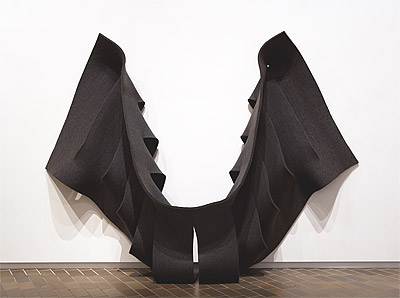Robert
MORRIS
United States of America
1931
Untitled
1969
felt
not signed, not dated
284.0 (h)
x 363.2 (w)
x 111.8 (d)
cm
Purchased 1975
National Gallery of Australia, Canberra
NGA 1975.152
© Robert Morris. Licensed by ARS & VISCOPY, Australia
Robert Morris, one of the foremost American Minimalist artists, is best known for his geometric plywood sculptures. From 1967 he also worked in felt. Initially the artist’s use of this pliant highly absorbent material was opportunistic (he was attracted by its cheapness or availability), but it became his preferred medium for almost a decade. In the earlier plywood works of the early to mid-1960s, Morris drew attention to the complex nature of the viewer’s experience of the object.[1] By emphasising the relationship between the work, the environment and the viewer interacting with his sculpture, Morris made the movement of the viewer and the changing conditions of the gallery into principal features of the work. In this sense, although his sculptures in wood look emphatically hard and immobile, they were intended to highlight the contingent nature of aesthetic experience.
In the later 1960s, in a series of texts including ‘Anti-form’ and ‘Some notes on the phenomenology of making’, Morris argued that to achieve this contingent aesthetic it was necessary to move beyond Minimalism.[2] He criticised his earlier, geometric sculptures for their over-emphasis on a pre-conceived approach to making―what he called the rational ideal of the ‘well built.’ This approach―now described by him as an arbitrary, imposed ordering system―did not sufficiently account for the processes of making accorded by the chosen material. He praised Jackson Pollock’s use of gravity and chance as examples of how one might allow the material itself to determine form. In opposition to building, Morris suggested dropping, hanging and leaning as suitable principles of making. These are the principles behind the production of this work, Untitled 1969.
Another way to read this work is to see the soft and pliable properties of the felt material as a way of obliquely referring to the human body. As the artist commented in a 1983 interview, ‘felt has anatomical associations; it relates to the body―it’s skinlike.’[3] In this sense, these works are not only about the idea of artistic contingency but also openly evoke the nature and experience of the body. In this way Morris moved beyond Minimalism’s subtle incorporation of the viewer’s movement into the experience of the work, to make open references to the material quality of the viewer’s body itself. Due to its variable nature, Untitled appears different at every installation. Depending on the profile of the felt, the work can suggest the look and feel of clothing worn close to the body; it can also carry a pathos, associated with the sagging, gravity-bound destination of all flesh.
Dr Anthony White
Lecturer in Art History
The University of Melbourne
[1] See, for example, Slab (platform) and Slab (cloud)—first constructed in plywood in 1962, and remade in painted aluminium in 1973; collection of the National Gallery of Australia
[2] The two texts were first published in Artforum; in 1968 (vi/8 1968, pp 33–5) and 1970 (viii/8, pp 62–6) respectively; both texts have been subsequently republished and are often quoted
[3] Robert Morris: the mind/body problem, Guggenheim Museum, New York, 1994, p 213

